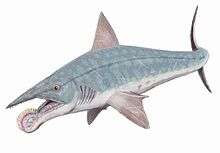Eugeneodontida
| Eugeneodontida Temporal range: 360–199.6 Ma | |
|---|---|
 | |
| Helicoprion bessonovi | |
| Scientific classification | |
| Kingdom: | Animalia |
| Phylum: | Chordata |
| Class: | Chondrichthyes |
| Subclass: | Holocephali |
| Order: | †Eugeneodontida Zangerl, 1981 |
| Superfamilies and Families | |
|
see text | |
| Synonyms | |
| |
Eugeneodontida is an extinct and poorly known order of bizarre cartilaginous fishes. They possessed a unique "tooth-whorl" on the symphysis of the lower jaw as well as pectoral fins supported by long radials. The palatoquadrate was either fused to the skull or reduced. Now determined to be within Holocephali, their closest living relatives are ratfish.[2] The meaning of the name Eugeneodont correlates to "true origin teeth", and comes from the Greek words eu (good/true), geneos(race, kind, origin) and odon (tooth.)
Members of Eugeneodontida are further classified into different families, the most well-preserved members that have been discovered are commonly placed within the families Helicoprionidae ("Spiral Saws"), and Edestidae ("Those which Devour"), the former containing the genera Helicoprion, Sarcoprion and Parahelicoprion, and the latter containing the genera Edestus, Listracanthus and Metaxyacanthus. All eugeneodonts are thought to be obligate carnivores, with each genera having specialized feeding behaviors, territory ranges and specific prey.
Taxonomy
- Family Eugeneodontidae
- Genus Bobbodus
- Genus Eugeneodus
- Genus Gilliodus
- Superfamily Edestoidea
- Family Helicoprionidae
- Genus Agassizodus
- Genus Arpagodus
- Genus Campyloprion
- Genus Helicoprion
- Genus Hunanohelicoprion
- Genus Parahelicoprion
- Genus Sarcoprion
- Genus Sinohelicoprion
- Genus Toxoprion
- Family Edestidae
- Genus Edestus
- Genus Helicampodus
- Genus Listracanthus
- Genus Lestrodus
- Genus Metaxyacanthus
- Genus Parahelicampodus
- Genus Physonemus
- Genus Prospiraxis
- Genus Syntomodus
- Family Helicoprionidae
- Superfamily Caseodontoidea
- Genus Campodus
- Genus Chiastodus
- Family Caseodontidae
- Genus Caseodus
- Genus Erikodus
- Genus Fadenia
- Genus Ornithoprion
- Genus Romerodus
New Discoveries
In 2013, a group of paleontologists discovered the true arrangement of Helicoprion's toothwhorl.[3]
In the same year, 2 specimens of an as yet undescribed species of Helicoprion were discovered. The first specimen suggests an animal that reached 10 meters in length, while the second specimen, nicknamed "Bois", suggests an animal that exceed 12 meters. This suggests that this species of Helicoprion is the largest known eugeneodont.[4]
References
- ↑ The Paleobiology Database - Eugeneodontiformes
- ↑ Tapanila L.; Pruitt J.; Pradel A.; Wilga C.; Ramsay J.; Schlader R.; Didier D. (2013). "Jaws for a spiral-tooth whorl: CT images reveal novel adaptation and phylogeny in fossil Helicoprion". Biology Letters. 9 (2). doi:10.1098/rsbl.2013.0057.
- ↑ http://phenomena.nationalgeographic.com/2013/02/26/buzzsaw-jaw-helicoprion-was-a-freaky-ratfish/
- ↑ http://www.eartharchives.org/articles/buzzsaw-toothed-leviathans-cruised-the-ancient-seas/
External links
- Palaeos Vertebrates 70.100 Chondrichthyes: Eugnathostomata at paleos.com
- JSTOR: Journal of Paleontology Vol. 70, No. 1 (Jan., 1996), pp. 162-165
- More about Chondrichthyes at Devonian Times